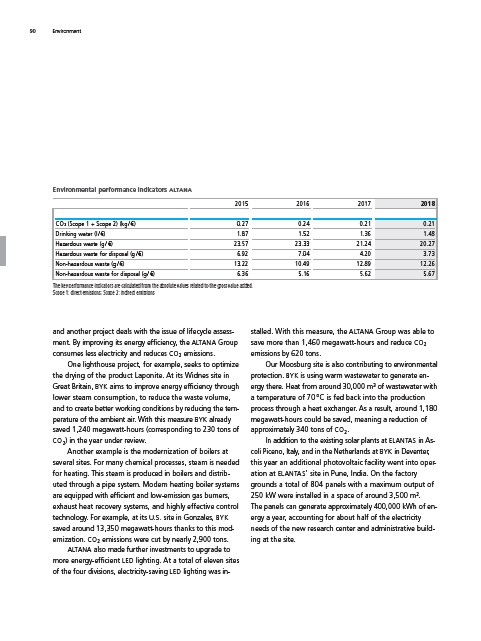
90 Environment
and another project deals with the issue of lifecycle assessment.
By improving its energy efficiency, the ALTANA Group
consumes less electricity and reduces CO² emissions.
One lighthouse project, for example, seeks to optimize
the drying of the product Laponite. At its Widnes site in
Great Britain, BYK aims to improve energy efficiency through
lower steam consumption, to reduce the waste volume,
and to create better working conditions by reducing the temperature
of the ambient air. With this measure BYK already
saved 1,240 megawatt-hours (corresponding to 230 tons of
CO²) in the year under review.
Another example is the modernization of boilers at
several sites. For many chemical processes, steam is needed
for heating. This steam is produced in boilers and distrib-
uted through a pipe system. Modern heating boiler systems
are equipped with efficient and low-emission gas burners,
exhaust heat recovery systems, and highly effective control
technology. For example, at its U.S. site in Gonzales, BYK
saved around 13,350 megawatt-hours thanks to this modernization.
CO² emissions were cut by nearly 2,900 tons.
ALTANA also made further investments to upgrade to
more energy-efficient LED lighting. At a total of eleven sites
of the four divisions, electricity-saving LED lighting was installed.
With this measure, the ALTANA Group was able to
save more than 1,460 megawatt-hours and reduce CO²
emissions by 620 tons.
Our Moosburg site is also contributing to environmental
protection. BYK is using warm wastewater to generate en-
ergy there. Heat from around 30,000 m³ of wastewater with
a temperature of 70 °C is fed back into the production
process through a heat exchanger. As a result, around 1,180
megawatt-hours could be saved, meaning a reduction of
approximately 340 tons of CO².
In addition to the existing solar plants at ELANTAS
in Ascoli
Piceno, Italy, and in the Netherlands at BYK in Deventer,
this year an additional photovoltaic facility went into operation
at ELANTAS’ site in Pune, India. On the factory
grounds a total of 804 panels with a maximum output of
250 kW were installed in a space of around 3,500 m².
The panels can generate approximately 400,000 kWh of energy
a year, accounting for about half of the electricity
needs of the new research center and administrative building
at the site.
Environmental performance indicators ALTANA
2015 2016 2017 2018
CO² (Scope 1 + Scope 2) (kg / € ) 0.27 0.24 0.21 0.21
Drinking water (l / € ) 1.87 1.52 1.36 1.48
Hazardous waste (g / € ) 23.57 23.33 21.24 20.27
Hazardous waste for disposal (g / € ) 6.92 7.04 4.20 3.73
Non-hazardous waste (g / € ) 13.22 10.49 12.89 12.26
Non-hazardous waste for disposal (g / € ) 6.36 5.16 5.62 5.67
The key performance indicators are calculated from the absolute values related to the gross value added.
Scope 1: direct emissions; Scope 2: indirect emissions